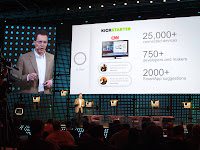wikipedia describles guerilla marketing as "...an unconventional system of promotions that relies on time, energy and imagination rather than a big marketing budget." so much about the theory, but how to put that in practice? let´s have a look at three recent examples.
the first one is from the last
barcamp vienna 2010 (thanks to the organizers
rolf &
max and the sponsors by the way!). when everyone was invited to post their proposed sessions, young photographer
christian lendl put up the following "
portrait photo for a link for a link" to his homepage.

by spending one hour of his time, he reached around 60 barcampers, almost a third of the attendants. now for marketers, that is a extremely good conversion rate! 60 people remember his name and will put links on their blogs, so his own website will rise in the search rankings, without one euro spend on adwords.
what about riding on the hype wave of someone else, to gain customer attention?
in this case it was the company
ifixyouri using the
apple ipone 4 hype to demonstrate their dedication towards their business: repairing iphones. the upcoming ihpone is supposed to use a 30 times more flexible front cover then used in the iphone 3gs and should therefore be less prone to breaking. at their company blog they published a post "
iphone 4 glass - will it break?" to check that out. so they took a new iphone 4 an threw it on the floor. the glass broke at the third try.

disproving the impression the one could get from apple´s presentation, that the new glass would be much more durable, brought them plenty of attention. cost? approximately 30-40 us$ (they sell the iphoen 4 glass repair for
69 us$, so their actual costs will be much lower).
considering the ranking on
techmeme and the respective discussion following, that was much more attention time then they would get for 40 us$ worth of printing standard marketing folders. p.s. that they maybe got inspired by "
will it blend" does not make this guerilla marketing any less effective.

let´s move on to a third example, graffiti style guerilla marketing. regardless if one considers graffiti as art or daub, they are everywhere and the are a provocative in every way. using graffiti in the public space form marketing purposes remains illegal though(at least here in austria).
although
sometimes graffiti are used without raising too much attention of the city authorities, this example of using graffiti style advertisement of
telering, a local austrian mobile phone network operator, did not go
unnoticed.
as telering was not allowed to spray the advertising message all over vienna the just thought different. why spraying colour on those walls which is forbidden when you can clean the walls - which is perfectly legal? so they did some selective cleaning, whileprotecting a dirty brick wall by a stencil. and that was the result:

again, the cost of the idea and "cleaning" their message on the walls showed true guerilla spirit and was in perfect relation to the attention gained.
that were three examples of great creative approaches to marketing. so what´s the guerilla marketing campaign for your start.up?
p.s. if the guerilla style sounds interesting, why not checking out another idea of conrad levinson´s book "guerilla marketing": "
5 words to describe your business".
 whatever new trend the it-sector is running after there is one common phenomena to be observed - and IoT is no exception to this. everyone like´s to be "the one" in the middle - the one to rule them all. thus not only enabling a multitude of services with reduced implementation time but also harvesting through system lock-in in the long run.
whatever new trend the it-sector is running after there is one common phenomena to be observed - and IoT is no exception to this. everyone like´s to be "the one" in the middle - the one to rule them all. thus not only enabling a multitude of services with reduced implementation time but also harvesting through system lock-in in the long run.

















 good leaver/bad leaver clauses gain 18%, up from 32 to 50% of the investments. most good leavers can expect to gain a fair valuation of their shares (73%, up from 49%) though.
good leaver/bad leaver clauses gain 18%, up from 32 to 50% of the investments. most good leavers can expect to gain a fair valuation of their shares (73%, up from 49%) though. anti dilution provisions are either weighted averages (51%) or full ratchets (35%), with a clear rise in the latter.
anti dilution provisions are either weighted averages (51%) or full ratchets (35%), with a clear rise in the latter.






